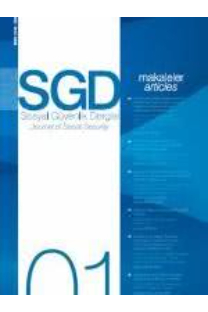Presentizm Olgusu
The Phenomenon of Presenteeism
___
- American Diabetes Association (2003), Economic Costs of Diabetes in the U.S. in 2002, Diabetes Care, 26, 917-932.
- Aronsson, Gunnar, Klas Gustafsson, Margareta Dallner (2000), Sick But Yet at Work. An Empirical Study of Sickness Presenteeism, Journal of Epidemiology and Community Health, 54: 7, 502-509.
- Aronsson, Gunnar, Klas Gustafsson (2005), Sickness Presenteeism: Prevalence, Attendance-Pressure Factors, and an Outline of a Model For Research, Journal of Occupational and Environmental Medicine, 47, 958-966.
- Biron, Caroline, Jean-Pierre Brun, Hans Ivers, Cary Cooper (2006), At Work But Ill: Psychosocial Work Environment and Well-Being Determinants Of Presenteeism Propensity, Journal of Public Mental Health, 5: 4, 26-37.
- Bramley, Thomas, J. Lerner, Sarnes Matthew (2002), Productivity Losses Related To The Common Cold Journal of Occupational and Environmental Medicine, 44: 822-829.
- Brouwer, Werner, BF MA Koopmanschap, FH Rutten (1999), Productivity Loses Without Absence: Measurement Validation and Empirical Evidence, Health Policy, 48: 1, 13-27.
- Burton, Wayne N., Glenn Pransky, Daniel. J Conti, Chin-Yu Chen, Dee W. Edington (2001), The Effects of Chronic Medical Conditions on Work Loss and Work Cutback, Journal of Occupational and Environmental Medicine, 43: 3, 218- 225.
- Burton, Wayne N., Glenn Pransky, Daniel J. Conti, Chin-Yu Chen, Dee W. Edington (2004), The Association of Medical Conditions and Presenteeism, Journal of Occupational and Environmental Medicine, 46: 6, 38-45.
- Burton, Wayne N., Daniel J. Conti, Chin- Yu Chen, Alyssa B. Schultz, Dee W Edington (1999), The Role of Health Risk Factors and Disease On Worker Productivity, Journal of Occupational & Environmental Medicine, 41: 10, 863- 877.
- Cullen, John, Andrew McLaughlin (2004), What Drives The Persistence of Presenteeism as Managerial Value In Hotels?: Observations Noted During an Irish Work-Life Balance Research Project, Hospitality Management, 25: 510-516.
- Çiftçi, Birgül (2010), İşte Var Ol(Ama)Ma Sorunu ve İşletmelerin Uygulayabileceği Çözüm Önerileri, Çalışma ve Toplum, 1,153-173.
- Goetzel, Ron Z., Stacey R. Long, Ronald J. Ozminkowski, Kevin Hawkins, Shaohung Wang, P. Wendy Lynch (2004), Health, Absence, Disability and Presenteeism: Cost Estimates of Certain Physical and Mental Health Conditions Affecting U.S. Employers, Journal of Occupational and Environmental Medicine, 46, 398-412.
- Gudgeon, Patrick, D.A. Wells, MO Baerlocher, AS Detsky (2009), Do You Come to Work With a Respiratory Tract Infection?, Occupational and Environmental Medicine, 66: 6, 424.
- Hansen, Claus D., Johan H. Andersen (2008), Going Ill to Work- What Personal Circumstances, Attitudes and Work-Related Factors Are Associated With Sickness Presenteeism?, Social Science & Medicine, 67: 6, 956-964.
- Hemp, Paul (2004), Presenteeism: At Work-But Out of It, Harvard Business Review, 82, 49-58.
- Johns, Gary (2010), Presenteeism in The Workplace: A Review And Research Agenda, Journal of Organizational Behavior, 31, 519-542
- Kessler, Ronald C., Wai Tat Chiu, Olga Demler, Ellen E. Walters (2005), Prevalence, Severity and Comorbidity of Twelve-Month DSM-IV Disorders In The National Comorbidity Survey Replication (NCS-R), Archives of General Psychiatry, 62, 617-627.
- Lamb, Charles E. Ratner, Paul H. Johnson, Clarion E. Ambegaonkar, J. Joshi Ambarish, V. Ashish, David Day, Najah Sampson, Benjamin Eng (2006), Economic Impact of Workplace Productivity Losses Due to Allergic Rhinitis Compared With Select Medical Conditions in the United States From an Employer Perspective, Current Medical Research and Opinion, 22, 1203-1210.
- Lee, Young-Mi (2010), Loss of Productivity Due to Depression Among Korean Employees, Journal Of Occupational Health, 52: 6, 389-394.
- MacGregor, James N., J. Barton Cunningham, Natasha Caverley (2008), Factors In Absenteeism and Presenteeism: Life Events and Health Events, Management Research News, 31: 8, 607-615.
- McKevitt, Christopher, Morgan Myfanwy, Ruth Dundas, W.W. Holland (1997), Sickness Absence and Working Through Illness: A Comparison of Two Professional Groups, Journal of Public Health, 19: 3, 295-300.
- Medibank, Sick at Work, 2011:2-11, www. medibank.com.au/Client/Documents/Pdfs/ sick_at_work.pdf, (29.03.2013). Middaugh, Donna J. (2006), Presenteeism: Sick and Tired at Work, MEDSURG Nursing, 15: 2, 103-105.
- Munir, Fehmidah, David Jones, Stavroula Leka, Amanda Griffiths (2005), Work Limitations and Employer Adjustments for Employees with Chronic Illness, International Journal of Rehabilitation Research, 28: 2, 111-117.
- Ricci, Judith, Walter F. Stewart, Elsbeth Chee, Carol Leotta, Kathleen Foley, Marc C. Hochberg (2005), Pain Exacerbation as a Major Source of Lost Productive Time in US Workers with Arthritis, Arthritis and Rheumatism, 53, 673-681.
- Schwartz, Brian S., Walter F. Stewart, Richard B. Lipton (1997), Lost Workdays and Decreased Work Effectiveness Associated With Headache in The Workplace, Journal of Occupational and Environmental Medicine, 39, 320-327.
- Schultz, Alyssa B., Dee W. Edington (2007), Employee Health and Presenteeism: A Systematic Review, Journal of Occupational Rehabilitation, 17: 3, 547-579.
- Stewart, Walter F., Judith A. Ricci, Elisabeth Chee, Steven R. Hahn, David Morganstein (2003), Cost of Lost Productive Work Time Among US Workers With Depression, Journal of the American Medical Association, 289, 31353144.
- Stewart, Walter F., Judith A. Ricci, Elisabeth Chee, David Morganstein (2003), Lost Productive Work Time Costs From Health Conditions in the United States: Results From the American Productivity Audit, Journal of Occupational and Environmental Medicine, 45: 12, 1234-1246.
- Virtanen, M., M. Kivimaki, M. Elovainio, J. Vahtera, E. Ferriej (2003), From Insecure to Secure Employment: Changes in Work, Health, Health Related Behaviours and Sickness Absence, Occupational and Environmental Medicine, 60: 12, 948-953.
- Widera, Eric, Anna Chang, Helen L. Chen (2010), Presenteeism: A Public Health Hazard, Journal of General Internal Medicine, 25:11, 1244-1247.
- ISSN: 2146-4839
- Yayın Aralığı: 2
- Başlangıç: 2011
- Yayıncı: SOSYAL GÜVENLİK KURUMU
Toplum yararına çalışma programı: İşsizlikle mücadelede yeni bir yöntem mi?
Yunus KÖLEOĞLU, Soner KARATASOĞLU, METE KAAN NAMAL
İş güvenliği kültürünün çalışanların güvenli davranışları üzerine etkisi
Mete Kaan NAMAL, Soner KARATAŞOĞLU, Yunus KÖLEOĞLU
Türkiye'de sosyal güvenlik sisteminin kurum ve kapsam olarak gelişimi ve sosyal güvenlik adaleti
İşletmelerde güvenlik kültürünün oluşumunda yönetimin rolü ve önemi
